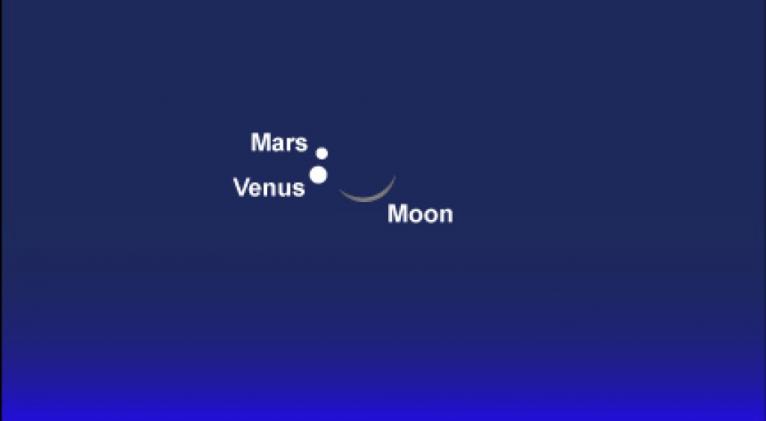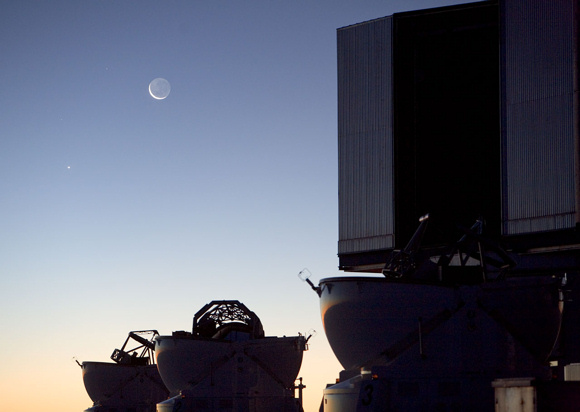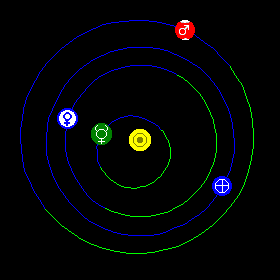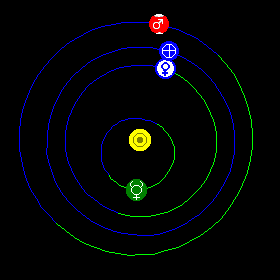Glorious moon and planets at nightfall February 20
especiales

As dusk ebbs into darkness, watch for the planet Mars to join the moon and Venus. If you have binoculars, aim them at Venus to enhance the view and spot Mars all the sooner in the darkening sky.
You’ll want to be looking westward beginning around 30 to 45 minutes after sunset on February 20. Don’t miss this spectacular sky scene if your sky is clear!
Although Mars shines as brightly as our sky’s brightest stars, Venus outshines the Red Planet by a good hundredfold. Venus and Mars have been edging closer together in the sky all month. They will have their conjunction – when the two worlds pass each other on the sky’s dome – on February 21. It’ll be their closest conjunction since September 11, 2008. And they won’t stage a closer one until October 5, 2017.
On February 21 – when Venus and Mars are in conjunction – the span between these two planets on the sky’s dome will be a scant 0.5 degree. That’s about a full moon’s diameter, in our sky.
Speaking of the moon, be sure to gaze at the dark side of the moon with either the unaided eye or binoculars. That soft glow on the moon’s night side is called earthshine, which is actually twice-reflected sunlight. The Earth reflects sunlight back to the crescent moon, and the dark side of the moon, in turn, again reflects sunlight back to Earth.
The lunar terminator – the shadow line dividing the lunar day from the lunar night – shows you where it’s sunrise on the waxing moon. With binoculars or a telescope, scan the terminator for the best three-dimensional views of the lunar terrain.
Enjoying EarthSky so far? Sign up for our free daily newsletter today!
EarthSky astronomy kits are perfect for beginners. Order today from the EarthSky store
 View larger A fine example of earthshine on the crescent moon, courtesy of the European Southern Observatory. That “star” to the lower left of the moon is actually the planet Venus.
View larger A fine example of earthshine on the crescent moon, courtesy of the European Southern Observatory. That “star” to the lower left of the moon is actually the planet Venus. From Earth, Mercury last occulted (passed in front of) Venus on August 20, 796. The sunset glare would have made this occultation hard to observe, however. Image credit: Solar System Live
From Earth, Mercury last occulted (passed in front of) Venus on August 20, 796. The sunset glare would have made this occultation hard to observe, however. Image credit: Solar System Live Looking into the future, Venus will occult (pass in front of) Mercury on December 3, 2133. Again, the glare of the setting sun will make this occultation hard to see.
Looking into the future, Venus will occult (pass in front of) Mercury on December 3, 2133. Again, the glare of the setting sun will make this occultation hard to see.Venus and Mars appear close now as seen in Earth’s sky. Does one planet ever pass in front of the other? It might surprise you to learn that the answer is yes!
Venus, the second planet outward from the sun, is one step inside Earth’s orbit. Meanwhile, Mars, the fourth planet outward, is one step outside Earth’s orbit. For this reason, as seen from Earth, it’s possible for Venus to occult – cover over – Mars. On the other hand, Mars can never occult Venus.
An occultation involving two planets is extremely rare, however. For instance, the last time Venus occulted Mars was on October 13, 1590, and the next time will be June 4, 2327.
From the vantage point of Earth, it’s also possible for Venus to occult Mercury – or for Mercury to occult Venus. That’s because Mercury, the closest planet to the sun, and Venus both reside inside Earth’s orbit (at present, by the way, Mercury isn’t an evening object, but is nearing its greatest elongation in the morning sky).
Venus is more likely to occult (pass in front of) Mercury, having last done so on May 28, 1737. Venus will next occult Mercury on December 3, 2133.
However, the last time Mercury occulted (passed in front of) Venus was on August 20, 796. And from what I can gather, the next time won’t be until March 14, 3129!
So occultations of one planet by another are exceedingly rare. But, actually, when you stop to think about it, each and every day presents a special and unique sky show in its own right.
Bottom line: While the time is at hand, enjoy the close grouping of the waxing crescent moon, and the planets Venus and Mars in the western sky as darkness falls on February 20, 2015!













Add new comment